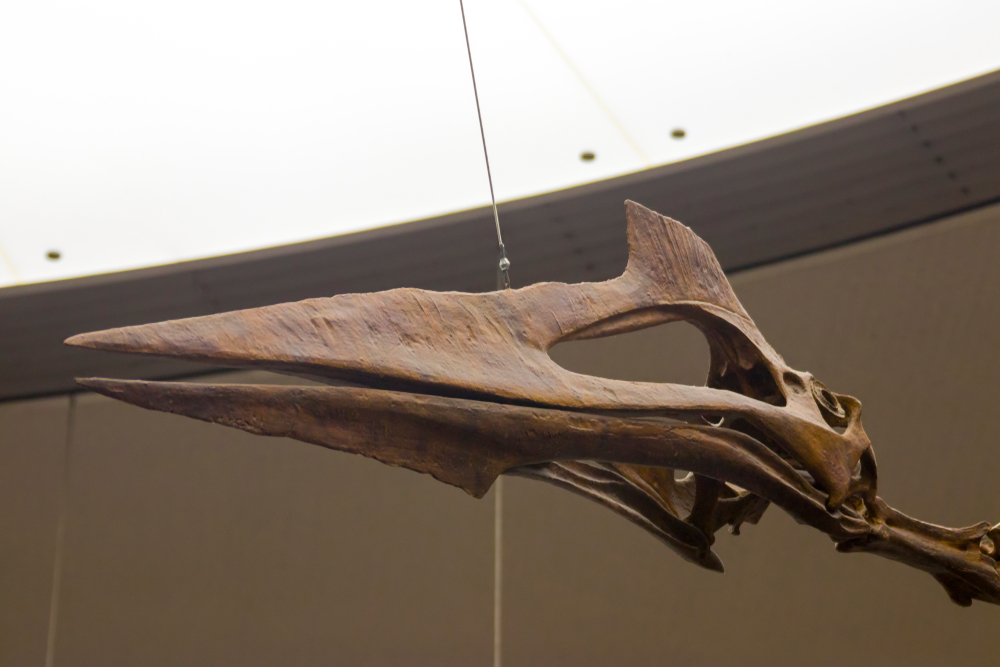How Big Was Quetzalcoatlus and Other Giant Pterosaurs?
Posted on Categories Discover Magazine

Pterosaurs, which means winged lizard in Greek, are often referred to as flying dinosaurs, but they aren’t actually dinosaurs.
They’re an extinct group of flying reptiles that ruled the skies starting 225 million years ago. Still, they’re more closely related to birds and dinosaurs than they are modern reptiles. And they were also the first vertebrae to leave land and take to the skies.
The Evolution of Pterosaurs
(Credit: Akkharat Jarusilawong/Shutterstock)
The earliest pterosaurs were smaller, with shorter limbs and longer tails. Later pterosaurs had longer limbs, making them better adapted for hunting on land. By 162 million years ago, pterosaurs started to have trackways similar to dinosaurs that lived on land, showing that they spent ample time walking on the ground. As time passed, pterosaurs grew, culminating with Quetzalcoatlus, an airborne beast that lived up until 66 million years ago.
Read More: Pterosaur Fossil Reveals the Evolutionary Origin of Feathers
Quetzalcoatlus: The Largest Animal to Ever Fly
(Credit:Warpaint/Shutterstock)
Between 72 and 66 million years ago, during the Late Cretaceous, lived the largest animal ever to soar the skies. It was nearing the end of the age of dinosaurs and Quetzalcoatlus, a vicious carnivore that ruled the skies, lived in the swampy wetlands of what is now Texas. The first Quetzalcoatlus specimen was collected in Big Bend National Park in the 1970s by Douglas Lawson, then a 22-year-old master’s student at the University of Texas.
Quetzalcoatlus Behaviors
Quetzalcoatlus was a flying reptile, not a bird. Once on land, it would tuck its wings underneath its arms and use them for balance. The females built nests in the wetlands where they would guard their giant eggs for weeks. This flying reptile was likely covered in a layer of fur and was also warm-blooded.
Quetzalcoatlus Wingspan
With a wingspan like a fighter jet at over 40 feet across, Quetzalcoatlus was the largest pterosaur ever to live. It likely hunted small dinosaurs on land but could also hold its own with larger predators when they fought over a discarded hunt. Scientists think that its gait allowed for hunting on land, rather than most modern birds of prey who swoop down and hunt their prey from above.
Read More: 107-Million-Year-Old Winged Reptile Found in Australia
The Most Famous Pterosaur: Pterodactyl
(Credit:frantic00/Shutterstock)
The Pterodactyl, known as Pterodactylus antiquus, is likely the most well-known of all the pterosaurs and also the first one discovered in the 18th century by Italian naturalist Cosimo Collini. While early research suggested that pterosaurs like Pterodactyl were cold-blooded animals that conserved energy by gliding through the air, newer data suggests that they were actually warmed-blooded, active animals.
Pterodactyl Characteristics
They lived in the Late Jurassic period between 161 and 145 million years ago, and their remains have been found in North America, Europe and Africa.
They ate fish and insects and had a much smaller wingspan compared to Quetzalcoatlus of about 5 feet. In pop culture, the term Pterodactyl has become a catch-all term for pterosaurs, but it was actually its own species.
Pterodactyl vs. Pteranodon
Pteranodons existed later in the age of dinosaurs compared to Pterodactyls in the Late Cretaceous period. Their specimens can be found throughout the midwestern U.S. in places like Kansas, South Dakota, Wyoming and Alabama. Their wingspans were about 21 feet across, and some research suggests that the males had larger head crests.
They likely ate marine species like fish and some crustaceans. In fact, some specimens have even been found with the remains of crustaceans fossilized in their throats. Though not the biggest pterosaur to ever live, Pteranodons were larger than Pterodactyls.
While we’re just beginning to learn about pterosaurs, we know that this cousin to the dinosaur thrived for millions of years throughout the age of dinosaurs until an enormous asteroid pounded Earth, causing the extinction of all landed dinosaurs and flying reptiles alike.
Read More: The End of Dinosaurs: The End-Cretaceous Mass Extinction